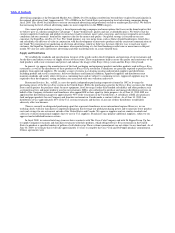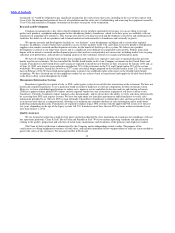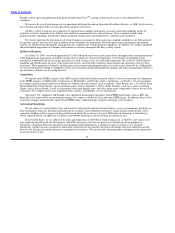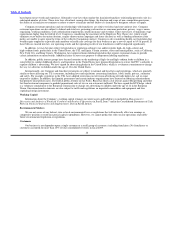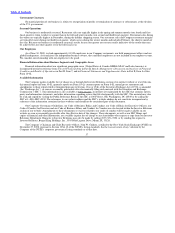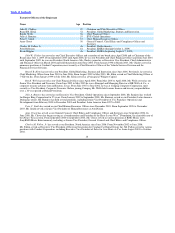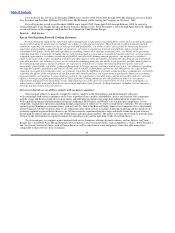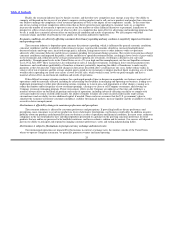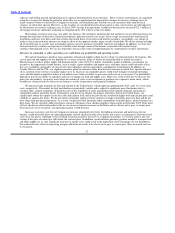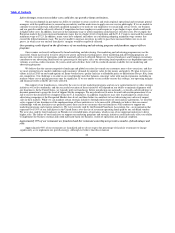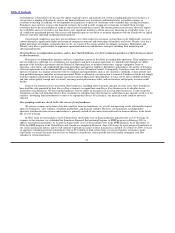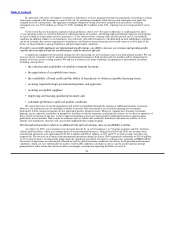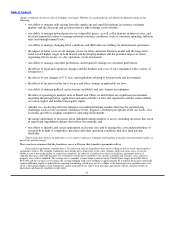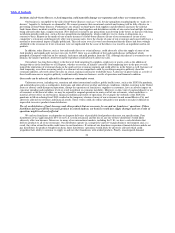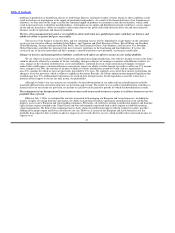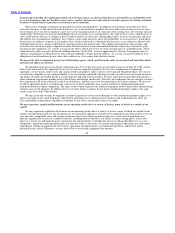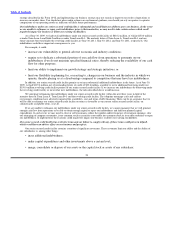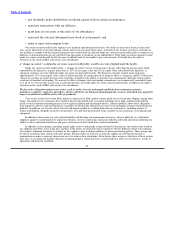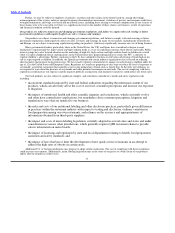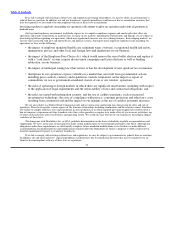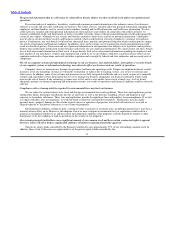Burger King 2009 Annual Report Download - page 25
Download and view the complete annual report
Please find page 25 of the 2009 Burger King annual report below. You can navigate through the pages in the report by either clicking on the pages listed below, or by using the keyword search tool below to find specific information within the annual report.
Table of Contents
ownership mix is beneficial to us because the capital required to grow and maintain our system is funded primarily by franchisees, it
also presents a number of drawbacks, such as our limited influence over franchisees and limited ability to facilitate changes in
restaurant ownership. In addition, we are dependent on franchisees to open new restaurants and to remodel their existing restaurants.
Franchisees may not have access to the financial resources they need in order to open new restaurants or remodel their existing
restaurants due to the unavailability of credit or other factors beyond their control. The current global recession may adversely impact
the availability and cost of credit to our franchisees. Any significant inability to obtain necessary financing on acceptable terms, or at
all, could slow our planned growth. Our success will depend in part on our ability to maintain alignment with our franchisees on capital
intensive and other operating and promotional initiatives.
Our principal competitors may have greater influence over their respective restaurant systems than we do. McDonald’s exercises
control through its significantly higher percentage of company restaurants and ownership of franchisee real estate. Wendy’s also has a
higher percentage of company restaurants than we do. As a result of the greater number of company restaurants, McDonald’s and
Wendy’s may have a greater ability to implement operational initiatives and business strategies, including their marketing and
advertising programs.
Our franchisees are independent operators, and we have limited influence over their restaurant operations or their decision to invest
in other businesses.
Franchisees are independent operators and have a significant amount of flexibility in running their operations. Their employees are
not our employees. Although we can influence our franchisees and their restaurant operations to a limited extent through our ability,
pursuant to the franchise agreements and our Manual of Operating Data, to mandate menu items, signage, equipment, hours of
operation, value menu, and standardized operating procedures and approve suppliers, distributors and products, the quality of franchise
restaurant operations may be diminished by any number of factors beyond our control. Consequently, franchisees may not successfully
operate restaurants in a manner consistent with our standards and requirements, such as our cleanliness standards, or may not hire and
train qualified managers and other restaurant personnel. While we ultimately can take action to terminate franchisees that do not comply
with the standards contained in our franchise agreements and our Manual of Operating Data, we may not be able to identify problems
and take action quickly enough and, as a result, our image and reputation may suffer, and our franchise and property revenues could
decline.
Some of our franchisees have invested in other businesses, including other restaurant concepts. In some cases, these franchisees
have used the cash generated by their Burger King restaurants to expand their non Burger King businesses or to subsidize losses
incurred by such businesses. We have limited influence over the ability of franchisees to invest in other businesses. To the extent that
franchisees use the cash from their Burger King restaurants to subsidize their other businesses rather than to pay amounts owed to us for
royalties, advertising fund contributions or rents or to expand their Burger King business, our financial results could be adversely
affected.
Our operating results are closely tied to the success of our franchisees.
We receive revenues in the form of royalties and fees from our franchisees. As a result, our operating results substantially depend
upon our franchisees’ sales volumes, restaurant profitability, and financial viability. However, our franchisees are independent
operators, and their decision to incur indebtedness is generally outside of our control and could result in financial distress in the future
due to over−leverage.
In 2003, many of our franchisees in the United States and Canada were in financial distress primarily due to over−leverage. In
response to this situation, we established the Franchisee Financial Restructuring Program, or FFRP program, in February 2003 to
address these financial problems. At its peak in August 2003, over 2,540 restaurants were in the FFRP program. As of December 31,
2006, the FFRP program in the United States and Canada was completed. However, there will always be a percentage of franchisees in
our system in financial distress and we will continue to provide assistance to these franchisees as needed. As of June 30, 2009, we have
an aggregate remaining potential commitment of up to $9.9 million to fund certain loans to renovate franchise restaurants, make
renovations to certain restaurants that we lease or sublease to franchisees, and to provide rent relief and/or contingent cash flow
subsidies to certain franchisees.
23


